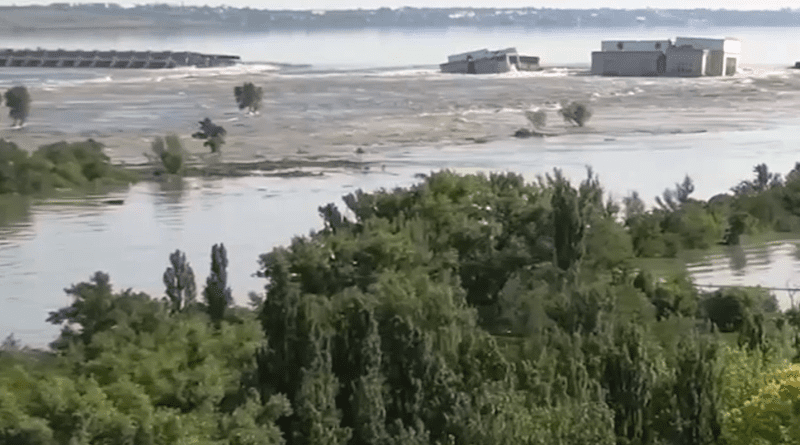Ukraine: Drinking Water Rushed To Those Stranded Or Fleeing Flooding After Dam Rupture
By VOA
Ukrainian authorities rushed drinking water to the southern part of the country on Wednesday to help thousands of people left stranded or fleeing the region a day after the rupture of the Kakhovka dam.
President Volodymyr Zelenskyy said hundreds of thousands of people were “without normal access to drinking water.”
He tweeted that the destruction of the dam at the defunct hydroelectric power station was “absolutely deliberate,” blaming Russian forces and further accusing Moscow of not acting to help those living in areas under Russian control who are now dealing with the effects of the flooding.
Ukrainian authorities said more than 17,000 people were being evacuated from areas along the Dnipro River with about 40 towns and villages flooded in areas under Ukrainian control. More than 900 people were evacuated from areas occupied by Russia.
But the true scope of the disaster for an area with 60,000 residents was not yet known.
Britain’s defense ministry said in its daily assessment Wednesday, “The dam’s structure is likely to deteriorate further over the next few days, causing additional flooding.”
Ukraine and Russia blamed each other for the destruction of the dam located about 70 kilometers east of Kherson in a part of Ukraine that Russia has controlled for more than a year.
Ukraine controls the western side of the Dnipro, while Russia holds the eastern territory, which is lower and more vulnerable to flooding. In Russian-occupied areas, as the flood waters kept rising, some residents waited on their rooftops to be rescued.
The water in the dam is critical for farming in the region and as a drinking water supply for the Crimean Peninsula, which Russia illegally seized in 2014.
It was not clear how the flooding will affect the war, with Ukraine preparing for a major counteroffensive aimed at recapturing territory Russia took in the earliest weeks of the conflict.
The Institute for the Study of War, a Washington research group, said Russia has “a greater and clearer interest in flooding the lower Dnieper, despite the damage to their own prepared defensive positions.” Dnieper is the Russian name for the Dnipro River.
Experts said the 1950s-era dam was believed to be in disrepair and vulnerable to collapse, as water was already brimming over when the wall gave way. It hadn’t been producing power since November, according to officials.
Britain’s Ministry of Defense said the Kakhovka reservoir was at “record high” water levels before the breach. While the dam wasn’t entirely washed away, the ministry warned that its structure “is likely to deteriorate further over the next few days.”
In Washington, the White House said Tuesday it could not say conclusively what caused the destruction of the massive dam but was assessing reports that the blast was caused by Russia.
At the United Nations, Secretary-General Antonio Guterres said attacks on civilians and civilian infrastructure must stop.
He said the “tragedy is yet another example of the horrific price of war on people. The floodgates of suffering have been overflowing for more than a year. That must stop.”
Consequences
Both Ukraine and Russia asked the U.N. Security Council to meet in an emergency session on the crisis.
U.N. humanitarian affairs chief Martin Griffiths told the meeting that the magnitude of the catastrophe would be fully realized only in the coming days, but it would have “grave and far-reaching consequences” for thousands of people on both sides of the front lines in southern Ukraine who have lost homes, livelihoods and safe drinking water.
“The destruction of the Kakhovka hydroelectric power plant dam is possibly the most significant incident of damage to civilian infrastructure since the start of the Russian invasion of Ukraine in February 2022,” Griffiths told council members.
He reiterated that international humanitarian law protects facilities such as dams because their destruction can cause severe loss for the civilian population.
Griffiths also expressed concern about the risk of the floodwaters moving landmines or spreading contamination from explosive weapons, further endangering civilians.
The dam supplied water to a swath of southern Ukraine’s agricultural territory and the Russian-occupied Crimean Peninsula, as well as cooling the Russian-controlled Zaporizhzhia Nuclear Power Plant, or ZNPP.
The Kakhovka reservoir, which is formed by the dam, provides water to cool ZNPP’s reactors and spent fuel pools.
Rafael Grossi, head of the International Atomic Energy Agency, said Tuesday the reservoir’s water levels had been falling throughout the day Tuesday, but the site has backup options, and there was no immediate risk to the nuclear plant’s safety.
Grossi, who will go to Ukraine next week, said a cooling pond next to the site could provide sufficient water “for some months” and called on all sides in Ukraine to ensure that it “remains intact.”
Russia seized control of the ZNPP early in its full-scale invasion of Ukraine, and Grossi has repeatedly highlighted the potential for a nuclear disaster if the area is not safeguarded.
U.N. correspondent Margaret Besheer contributed to this report.

